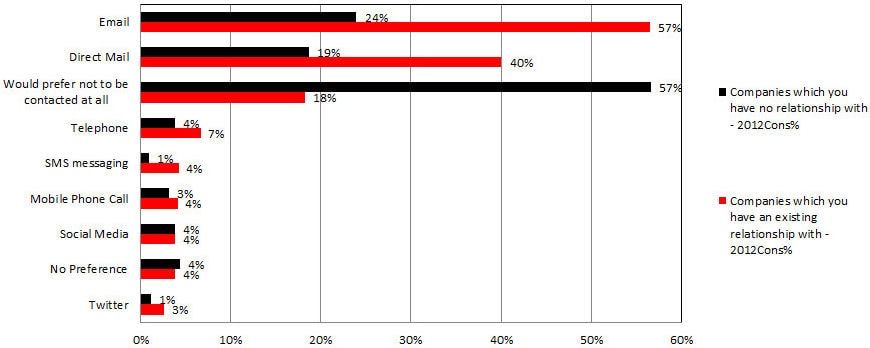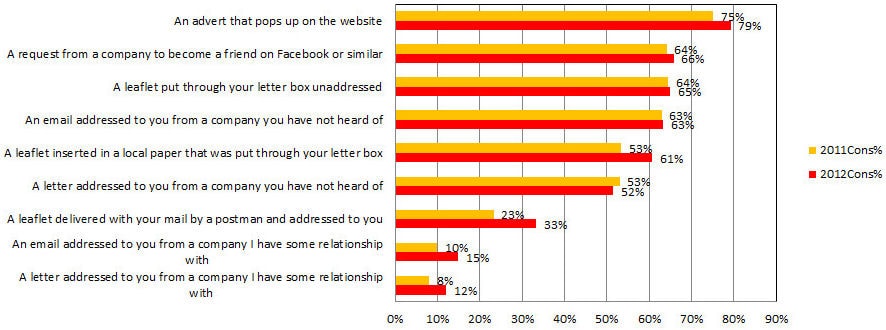Digital messaging may be popular with PROs, but it seems consumers are less keen to hear from companies on computers and mobiles. According to latest research from fast.MAP, eight out of ten consumers are open to contact from companies they use, albeit not via social media it would seem, and there is a two per cent year-on-year drop, to 57 per cent, in those who do not want to be contacted by companies they don’t use. This follows a six per cent drop, from 65 per cent in 2010, to 59 per cent in 2011.
Managing director of fast.MAP, David Cole, comments. “This indicates a steady trend of people being more open to cold contact about goods and services from brands they are not currently using. Unfortunately, there has been a simultaneous two per cent year-on-year increase, from 16 per cent to 18 per cent, in those who prefer not to be contacted, even by companies they use.”
Of the just-under four in five people who do want to be contacted by companies where there is a relationship, 57 per cent are happy with email; 40 per cent mail; 7 per cent telephone; but only around one in twenty-five are happy to be contacted via any of the other media.
What is your preferred method of communication from marketing companies?

Source: fast.MAP
Of the two in five who are open to contact by any company; 24 per cent are happy with email; 19 per cent mail; and between 1 per cent and 4 per cent various other media.
79 per cent of consumers close website pop-ups unread, while three in five ignore social media “friending” requests; unaddressed door-drop leaflets and emails from unrecognised companies. “There are an awful lot of digital messages out there that are destined never to be heard or seen,” says Cole. “Just because you’re creating endless streams of information doesn’t mean that anyone is receiving it.
Which of the following types of advertising do you ignore/delete/throwaway immediately without looking?

Source: fast.MAP
“This tracking study illustrates that people are actively avoiding contact by several digital routes; while still being willing to assimilate information via traditional media. It’s very tempting for PR departments to get carried away with enthusiasm for digital communication, but they should be aware that the vast majority are far more open to brand contact when it comes via less-intrusive, more-traditional routes.”
Not surprisingly, Akudo Ike, PR manager at Royal Mail is happy with the findings: “There is a lot of noise in the communication sphere. Different channels are competing for their share of voice, with the aim of getting the public’s attention, influencing their behaviour or changing their attitude. This research shows that digital channels should not be used in isolation and that targeted mail is an effective form of communication.”
Background
Data and analysis is from the eighth (2012) fast.MAP Marketing-GAP Report, launched by fast.MAP in 2005 and tracking annually since then. The report is sponsored by Market Reach, part of Royal Mail; and produced in partnership with the Institute of Promotional Marketing (IPM) and Institute of Direct Marketing (IDM). The questionnaire was broadcast during July/ August 2012 and completed by more than 1,000 consumers on the fast.MAP panel which mirrors the UK’s demographic profile.
If you enjoyed this article, sign up for free to our twice weekly editorial alert.
We have six email alerts in total - covering ESG, internal comms, PR jobs and events. Enter your email address below to find out more:






